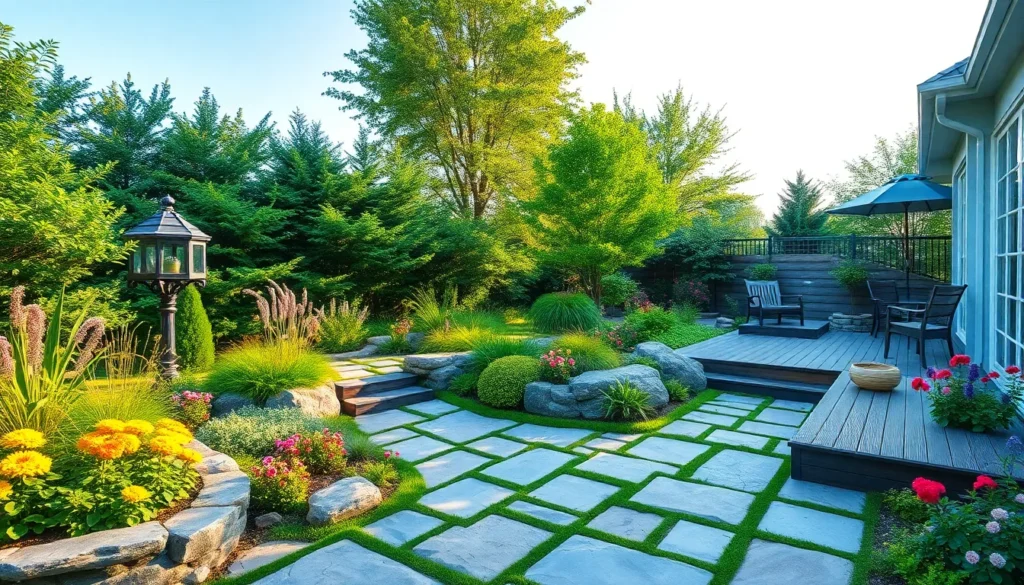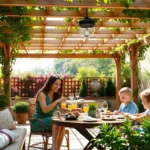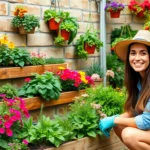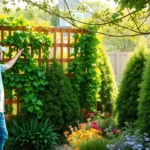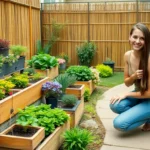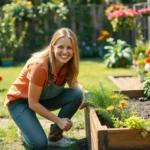Creating the perfect outdoor sanctuary starts from the ground up. Garden flooring transforms ordinary yards into stunning extensions of our homes where we’ll actually want to spend time relaxing and entertaining. Whether we’re dealing with muddy pathways patchy grass or boring concrete we’ve got countless options to elevate our outdoor spaces.
From budget-friendly gravel and mulch to luxurious natural stone and composite decking the right flooring choice depends on our style preferences maintenance expectations and how we plan to use the space. Smart garden flooring doesn’t just look amazing – it also solves practical problems like drainage poor soil conditions and high-traffic wear patterns.
We’ll explore creative answers that work for every budget and garden size. These proven flooring ideas will help us design outdoor spaces that seamlessly blend functionality with visual appeal making our gardens the envy of the neighborhood.
Natural Stone Pathways for Timeless Garden Appeal
Natural stone pathways create lasting beauty that complements any garden style while providing durable flooring answers. We’ll explore the most effective installation methods and material choices to help you achieve professional results.
Flagstone Installation and Design Tips
Flagstone installation requires proper ground preparation to ensure long-lasting results. We recommend excavating 4-6 inches deep and creating a stable base using crushed gravel and sand. Level the area carefully before placing each stone to prevent shifting over time.
Design patterns can dramatically impact your pathway’s visual appeal. Consider using irregular flagstone pieces for a natural, flowing appearance that works well in cottage and woodland gardens. Rectangular cuts create more formal pathways suitable for contemporary outdoor spaces.
Joint spacing between flagstone pieces should measure 1-2 inches for optimal stability. Fill gaps with polymeric sand, moss, or low-growing plants like thyme to create different aesthetic effects. Polymeric sand prevents weed growth while maintaining clean lines between stones.
Slate and Limestone Options for Different Climates
Slate performs exceptionally well in regions with frequent freeze-thaw cycles due to its low water absorption rate. We find that slate pathways resist cracking and maintain their appearance through harsh winter conditions. Choose darker slate colors to help with ice melting during colder months.
Limestone offers excellent durability in moderate climates but requires careful selection in areas with heavy rainfall. Dense limestone varieties withstand moisture better than porous options. Apply sealers annually in wet climates to protect limestone surfaces from water damage and staining.
Climate considerations should guide your material choice for optimal longevity. Northern regions benefit from slate’s frost resistance, while southern areas can accommodate limestone’s softer appearance. Both materials develop attractive patina over time when exposed to natural weathering.
Cost Considerations for Natural Stone Flooring
Natural stone flooring costs vary significantly based on material type and installation complexity. We typically see flagstone priced between $15-25 per square foot installed, while premium slate can reach $30-40 per square foot. Limestone generally falls in the middle range at $20-30 per square foot.
| Stone Type | Cost Per Sq Ft (Installed) | Durability Rating | Maintenance Level |
|---|---|---|---|
| Flagstone | $15-25 | High | Low |
| Slate | $25-40 | Very High | Very Low |
| Limestone | $20-30 | Medium-High | Medium |
Labor costs account for 40-60% of total project expenses depending on site accessibility and design complexity. DIY installation can reduce costs by $8-15 per square foot but requires proper tools and experience. Factor in equipment rental costs including plate compactors, stone saws, and leveling tools when planning your budget.
Long-term value makes natural stone pathways worthwhile investments even though higher upfront costs. These materials last 25-50 years with minimal maintenance compared to concrete or pavers that may need replacement after 10-15 years.
Wooden Decking Solutions for Outdoor Living Spaces

Wooden decking transforms outdoor spaces into functional living areas that extend our homes seamlessly into the garden. We can choose between natural wood and composite materials to create the perfect foundation for entertaining, relaxing, and enjoying our outdoor sanctuary.
Composite vs. Natural Wood Comparison
Natural wood decking offers authentic beauty with varied grain patterns and colors that we can customize through staining or painting. Traditional options like cedar, teak, and pressure-treated lumber provide classic appeal but require ongoing maintenance to preserve their appearance and structural integrity.
Composite decking mimics wood’s natural look while delivering superior durability and weather resistance. Made from recycled wood fibers and plastic, these boards won’t warp, splinter, or fade like traditional lumber, making them ideal for high-traffic outdoor areas.
| Feature | Natural Wood | Composite Decking |
|---|---|---|
| Appearance | Natural, varied grain patterns | Consistent wood-like texture |
| Durability | 10-15 years with maintenance | 25-30 years minimal care |
| Maintenance | Annual staining/sealing required | Occasional cleaning only |
| Cost | $15-40 per square foot installed | $25-60 per square foot installed |
| Weather Resistance | Susceptible to rot and insects | Moisture and pest resistant |
Maintenance Requirements for Wooden Garden Floors
Natural wood decking demands regular attention to maintain its beauty and prevent deterioration. We must apply protective stains or sealers every 1-2 years to shield the wood from moisture, UV rays, and temperature fluctuations that cause cracking and warping.
Power washing removes dirt and mildew buildup but requires careful technique to avoid damaging the wood surface. Gentle cleaners and soft brushes work better for routine maintenance, preserving the wood’s natural texture while removing accumulated grime.
Composite decking requires minimal upkeep compared to natural alternatives. We simply need to sweep away debris regularly and wash with soap and water to maintain its appearance, though stubborn stains may require specialized composite deck cleaners.
Creative Pattern and Layout Ideas
Herringbone patterns create sophisticated visual interest by alternating board directions at 45-degree angles. This classic design works particularly well in smaller spaces where we want to add texture without overwhelming the area with busy patterns.
Diagonal installations make narrow spaces appear wider while adding ever-changing movement to our deck design. Running boards at 45-degree angles to the house creates an illusion of expanded space and draws the eye toward focal points like garden beds or water features.
Curved lines follow our garden’s natural contours and create flowing transitions between different outdoor zones. We can achieve gentle curves using flexible composite boards or by cutting traditional lumber to follow custom templates that match our industry design.
Border inlays using contrasting colors or materials define edges and create custom focal points throughout our decking area. Picture frame borders using darker tones highlight the main decking surface while decorative medallions or geometric patterns add personalized touches that reflect our style preferences.
Gravel and Pebble Flooring for Low-Maintenance Gardens
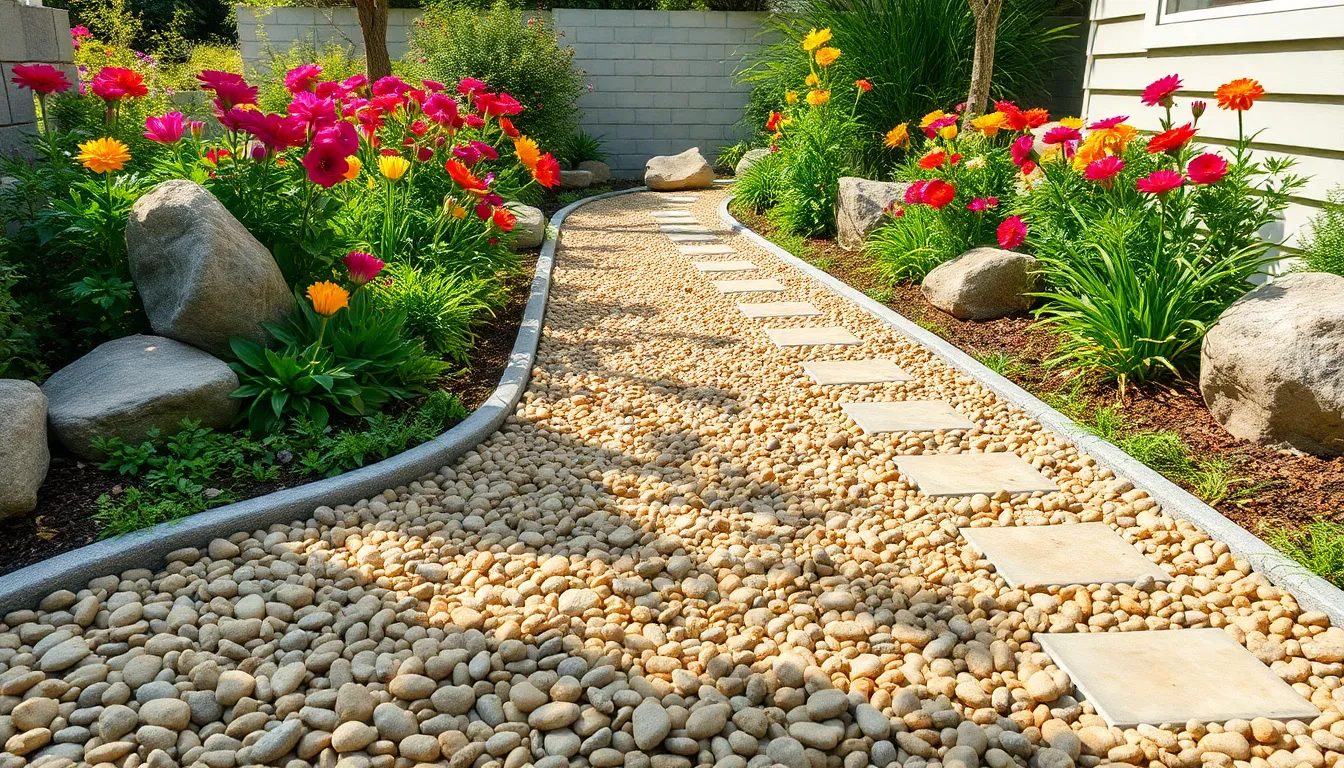
Gravel and pebble flooring offers an exceptional solution for gardeners who want beautiful outdoor spaces without constant upkeep. These materials require only occasional raking and weed removal, making them perfect for busy homeowners seeking both practicality and natural charm.
Choosing the Right Gravel Size and Color
Selecting appropriate gravel size determines both comfort and functionality in our garden spaces. Smaller, smoother pebbles or pea gravel create comfortable walking surfaces while providing versatile design options. We find that these smaller stones work best for high traffic areas where people will walk regularly.
Color selection significantly impacts our garden’s overall atmosphere and visual cohesion. Earthy tones like brown, gray, and ivory help create harmonious looks that blend naturally with outdoor environments. Lighter colors brighten darker garden areas and make spaces feel more open, while darker shades add dramatic contrast and sophisticated appeal.
Larger gravel serves different purposes in our garden design strategy. We use these bigger stones as decorative accents or foundational base layers underneath smaller materials. This layered approach provides better stability and creates interesting textural variations throughout the space.
Proper Installation and Edging Techniques
Installation success begins with creating a level, compacted foundation for our gravel flooring. We recommend using sand or crushed stone as the base layer to ensure proper drainage and prevent settling over time.
Edging materials play a crucial role in maintaining clean, defined garden boundaries. Weather resistant boards, metal strips, and stone borders keep gravel and pebbles contained while preventing material migration into surrounding areas. We install edging at the same height as our gravel layer to achieve the most polished, professional appearance.
Proper edging techniques also provide long term maintenance benefits for our garden floors. These borders create clear separation between different garden zones and make routine upkeep tasks like raking much easier to accomplish.
Drainage Benefits of Loose Stone Materials
Loose stone flooring delivers exceptional water management capabilities through its highly permeable surface structure. Water drains efficiently through gravel and pebble materials, eliminating puddle formation and reducing flooding risks during heavy rainfall periods.
Natural drainage properties make these materials particularly suitable for regions with challenging weather conditions. We recommend loose stone flooring for areas that experience frequent rain or require effective water runoff management systems.
Soil health improvements result from the porosity and durability of gravel flooring systems. These materials reduce ground compaction while promoting better root aeration, creating healthier growing conditions for surrounding plants and landscaping elements.
Brick and Paver Designs for Classic Garden Charm
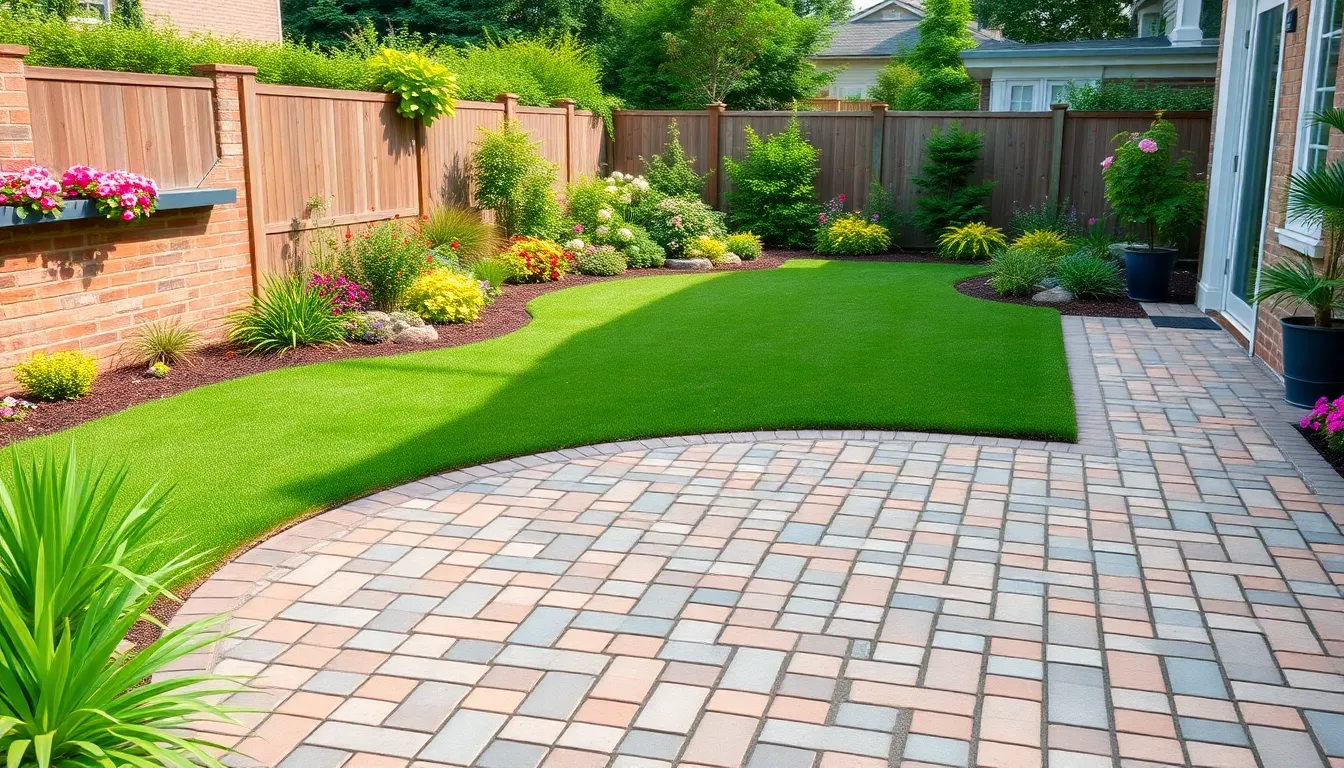
Moving beyond loose materials, brick and paver designs bring enduring elegance to our garden spaces through their structured appearance and versatile styling options.
Traditional vs. Modern Brick Laying Patterns
Traditional brick patterns offer time-tested appeal through their proven durability and visual harmony. Running bond patterns—where bricks are laid in straight rows offset by half a brick—provide simplicity and structural strength that’s perfect for pathways and patios. Basketweave arrangements create intricate, interlocking designs that add texture and classic elegance to any outdoor space.
Modern approaches blend traditional materials with contemporary creativity through circular, radial, or mixed-material layouts. We can combine bricks with larger pavers or contrasting stones to achieve a fresh twist on classic designs. These innovative patterns allow for more creative expression while maintaining the structural integrity that makes brick flooring so reliable.
Herringbone patterns bridge traditional and modern aesthetics by offering both visual interest and enhanced stability. Complex interlocking designs distribute weight evenly across surfaces, making them ideal for high-traffic areas where durability matters most.
Permeable Paver Options for Eco-Friendly Gardens
Permeable pavers revolutionize sustainable garden flooring by allowing water to pass through gaps or specially designed surfaces. These innovative systems reduce runoff and support groundwater recharge, making them essential for environmentally conscious landscaping projects.
Open-cell pavers work exceptionally well in eco-friendly gardens by managing stormwater while minimizing environmental impact. Crushed stone installations provide excellent drainage capabilities while maintaining visual appeal throughout changing seasons. Porous concrete options offer another sustainable alternative that combines functionality with modern aesthetics.
Sustainable drainage benefits extend beyond water management to improve overall soil health and plant growth. We see reduced erosion and better root aeration when permeable systems replace traditional solid surfaces in our garden designs.
Color Combinations and Design Inspiration
Color choices transform basic brick and paver installations into stunning focal points through strategic combinations and creative contrasts. Traditional reds and browns provide warm, inviting tones that complement natural garden elements and established industry features.
Modern palettes expand our options with grays, tans, and multicolor blends that create sophisticated outdoor environments. We can highlight exact garden features by combining different hues within the same pattern or mixing complementary materials for enhanced visual flow.
Contrasting borders add definition and structure to our garden flooring designs while decorative inlays create personalized touches that reflect individual style preferences. Mixed-material approaches allow us to incorporate both classic and contemporary elements for truly unique outdoor spaces.
Accent features draw inspiration from both traditional craftsmanship and modern design principles, creating garden floors that enhance rather than compete with surrounding plantings and architectural elements.
Concrete Garden Flooring for Contemporary Landscapes
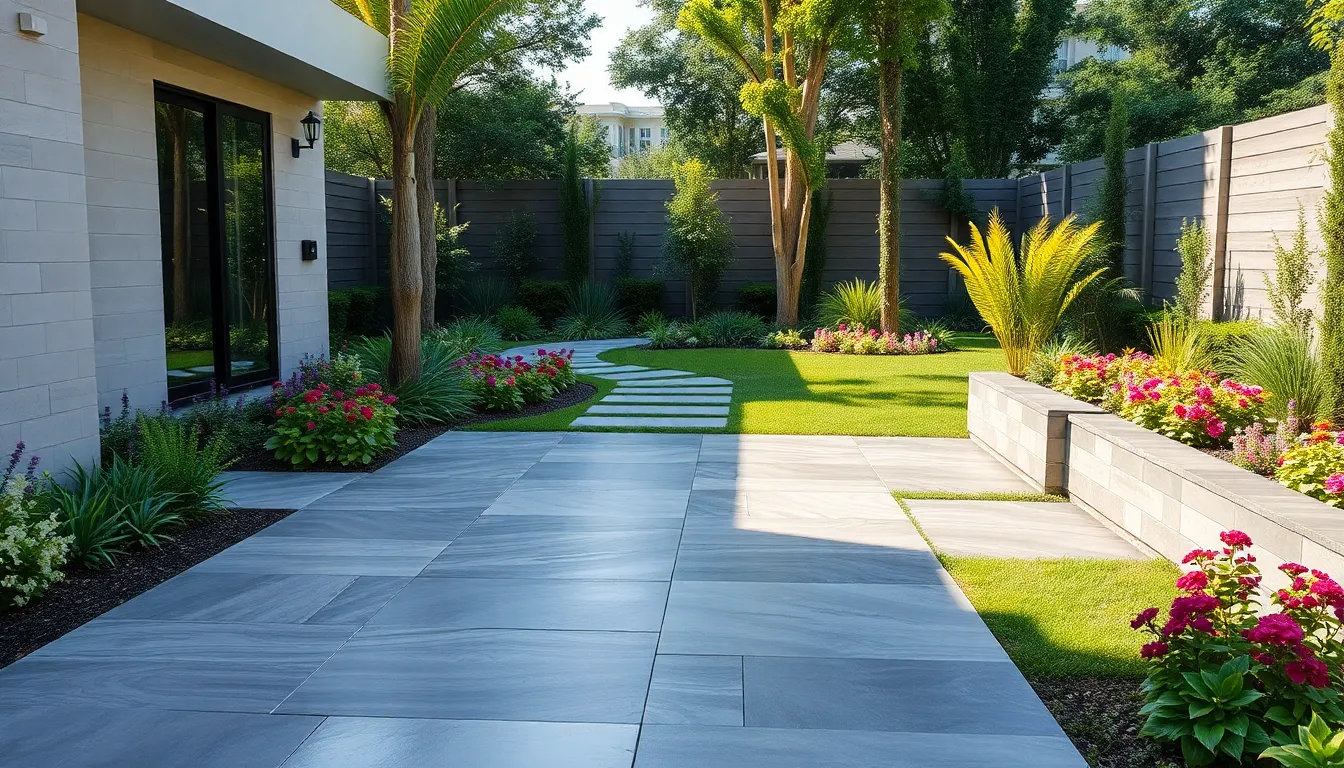
Concrete garden flooring offers exceptional versatility for modern outdoor spaces while providing long-lasting durability that complements contemporary design aesthetics.
Stamped and Textured Concrete Finishes
Stamped concrete transforms ordinary surfaces into sophisticated focal points that mimic expensive materials at a fraction of the cost. Patterns resembling natural stone create elegant pathways that blend seamlessly with surrounding landscaping elements. Brick-inspired designs add timeless charm while maintaining the practical benefits of concrete’s weather resistance.
Textured finishes enhance both safety and visual appeal by providing improved slip resistance during wet conditions. We recommend selecting patterns that complement your home’s architectural style and existing hardscape features. The versatility of stamped concrete allows for endless customization possibilities, from subtle wood grain textures to bold geometric patterns that make striking design statements.
Staining and Coloring Techniques
Chemical stains penetrate deep into concrete surfaces, creating rich, variegated colors that won’t peel or fade over time. Earth tones like terracotta, sage green, and warm browns complement natural garden elements beautifully. Multiple stain applications can achieve complex color variations that replicate the natural beauty of aged stone or weathered wood.
Integral coloring mixes pigments directly into the concrete before pouring, ensuring consistent color throughout the entire surface. This technique works particularly well for larger installations where uniform appearance is essential. Acid-based stains react with concrete minerals to produce unique, mottled effects that add character and depth to contemporary landscapes.
Color matching becomes easier when we coordinate concrete hues with existing outdoor elements like retaining walls, planters, or architectural features. Strategic color choices can visually expand smaller spaces or create defined zones within larger garden areas.
Budget-Friendly DIY Installation Methods
Concrete pavers offer an accessible entry point for DIY enthusiasts who want professional-looking results without extensive construction experience. Interlocking tiles simplify the installation process while providing flexibility for future modifications or repairs. These modular systems require basic tools and can typically be completed over a weekend.
Peel and stick tiles provide the quickest transformation option for existing concrete surfaces that need cosmetic updates. Surface preparation involves thorough cleaning and minor crack repairs to ensure proper adhesion. Installation costs remain minimal since most homeowners can handle the process independently with basic hand tools.
Proper base preparation determines the longevity of any DIY concrete flooring project. Sand leveling creates the stable foundation necessary for preventing future settling or cracking issues. Edge restraints maintain clean boundaries and prevent material shifting during weather changes or heavy foot traffic.
Artificial Grass and Synthetic Turf Applications
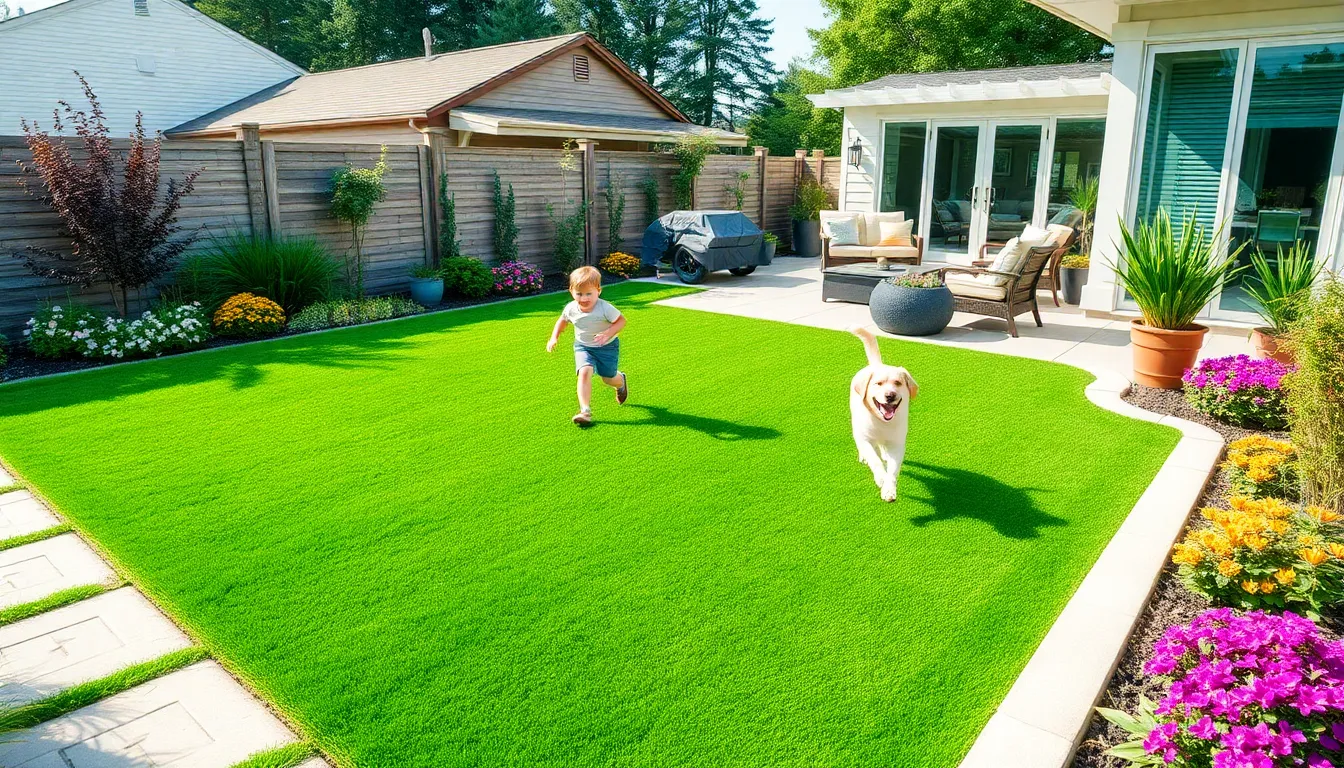
Moving beyond traditional hard surfaces, artificial grass and synthetic turf offer revolutionary answers for modern garden flooring needs. These versatile materials transform outdoor spaces while addressing common landscaping challenges.
Maintenance-Free Lawn Alternatives
Artificial grass eliminates the endless cycle of watering, mowing, and fertilizing that natural lawns demand. We find this flooring option particularly valuable for homeowners seeking beautiful green spaces without weekend maintenance commitments. Synthetic turf withstands heavy foot traffic and weather extremes while maintaining its pristine appearance year-round.
Durability becomes especially important in high-traffic areas where natural grass struggles to survive. Commercial applications like dog parks and public spaces rely on synthetic materials because they resist wear patterns that would destroy traditional lawns. Sports fields and recreational areas benefit from consistent playing surfaces that don’t develop bare patches or muddy spots during rainy seasons.
Cost effectiveness emerges through long-term savings on water bills, lawn equipment, and ongoing maintenance expenses. We’ve observed homeowners save hundreds of dollars annually by switching from natural grass to quality synthetic alternatives.
Pet-Friendly Synthetic Flooring Options
Pet turf incorporates specialized antimicrobial agents like Microban that actively combat bacteria and eliminate odors from pet waste. We recommend these enhanced materials for dog owners who want safe, hygienic outdoor spaces for their companions. Easy cleaning becomes possible with simple water rinses that remove waste and debris completely.
Safety features include non-toxic materials and rounded fiber tips that protect pet paws from irritation. High-quality synthetic grass resists tearing and maintains its structure even with constant digging and running activities. Drainage systems built into pet-exact turf prevent liquid accumulation and bacterial growth.
Antimicrobial protection continues working throughout the turf’s lifespan, ensuring ongoing freshness and cleanliness. We’ve seen pet owners appreciate how synthetic options eliminate muddy paw prints and grass stains on carpets and furniture.
Installation Over Different Base Materials
Sand or gravel bases provide excellent drainage and stability for most synthetic turf installations. We typically recommend these loose materials because they allow proper water flow while creating level surfaces for optimal turf performance. Proper preparation involves compacting the base material and ensuring adequate slope for water management.
Concrete bases work well in areas requiring maximum stability, such as rooftops or heavily trafficked commercial spaces. Existing lawn installations become possible when proper ground preparation removes organic materials and creates appropriate drainage systems. Versatile application means we can install synthetic turf over various substrates with suitable preparation techniques.
Professional installation ensures proper base selection and preparation methods that maximize turf longevity and performance. We always evaluate drainage requirements, intended use patterns, and local climate conditions when selecting appropriate base materials for each project.
Rubber and Recycled Material Flooring Ideas
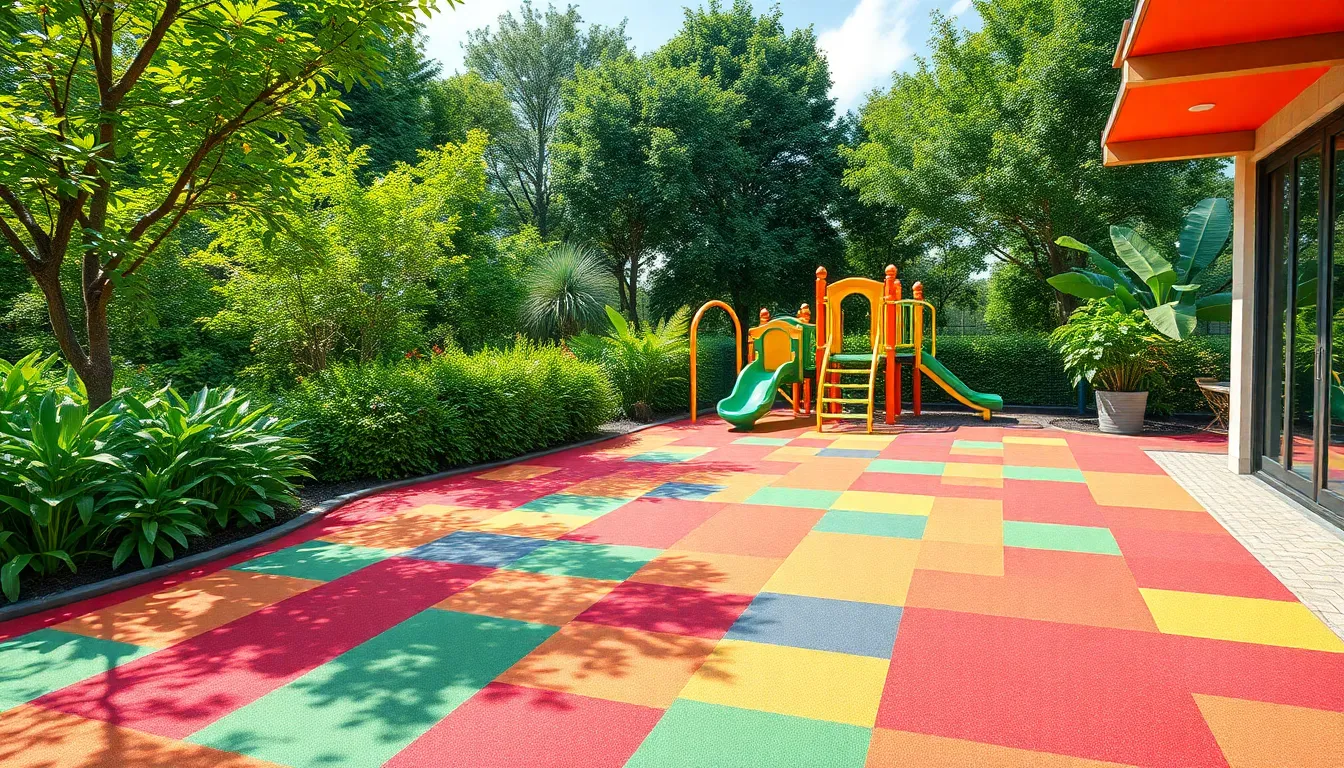
Moving beyond traditional materials, we’re exploring sustainable flooring options that combine environmental responsibility with practical functionality for our outdoor spaces.
Safety Benefits for Play Areas and Walkways
Rubber flooring provides exceptional shock absorption that significantly reduces injury risks from falls, making it the perfect choice for children’s play areas and high-traffic walkways. This protective cushioning effect gives us peace of mind while our families enjoy outdoor activities.
Slip resistance remains consistent even during wet conditions, ensuring safe navigation throughout all seasons and weather patterns. We can confidently design pathways and recreational spaces knowing that rubber surfaces maintain their grip when moisture is present.
Key Safety Features:
| Safety Benefit | Description |
|---|---|
| Shock Absorption | Cushions falls and reduces impact injuries |
| Slip Resistance | Maintains traction in wet conditions |
| Surface Stability | Provides secure footing for all ages |
Eco-Friendly Recycled Tire Options
Recycled tire rubber flooring transforms waste materials into functional garden surfaces, directly supporting environmental sustainability while reducing landfill burden. Premium options like VersaTREAD tiles contain up to 92% recycled rubber content, demonstrating our commitment to eco-conscious landscaping choices.
Polyurethane binders combine with recycled tire materials to create robust surfaces that retain essential elasticity and safety characteristics. This innovative approach allows us to repurpose old tires into durable flooring answers that serve our gardens for decades.
Manufacturing processes for recycled rubber flooring require significantly less energy compared to producing new materials from scratch. We’re actively participating in the circular economy by choosing these sustainable alternatives for our outdoor living spaces.
Weather Resistance and Durability Features
UV ray resistance protects rubber flooring from harsh sunlight exposure, preventing degradation and color fading that commonly affects other outdoor materials. Ozone resistance further enhances longevity by maintaining structural integrity even though atmospheric exposure.
Durability characteristics of recycled rubber flooring enable these surfaces to withstand heavy foot traffic, playground equipment, and extreme weather conditions without compromising performance. We can expect minimal maintenance requirements over the material’s extended lifespan.
Durability Specifications:
| Feature | Performance |
|---|---|
| UV Resistance | Withstands harsh sunlight exposure |
| Weather Tolerance | Handles extreme temperature fluctuations |
| Maintenance | Requires minimal upkeep over decades |
| Traffic Capacity | Supports heavy use in active areas |
Long term investment value becomes apparent through decades of reliable service with minimal replacement needs, making rubber flooring cost effective even though higher initial expenses. This durability factor positions recycled rubber as a smart financial choice for our garden flooring projects.
Creative Mixed-Material Garden Floor Combinations
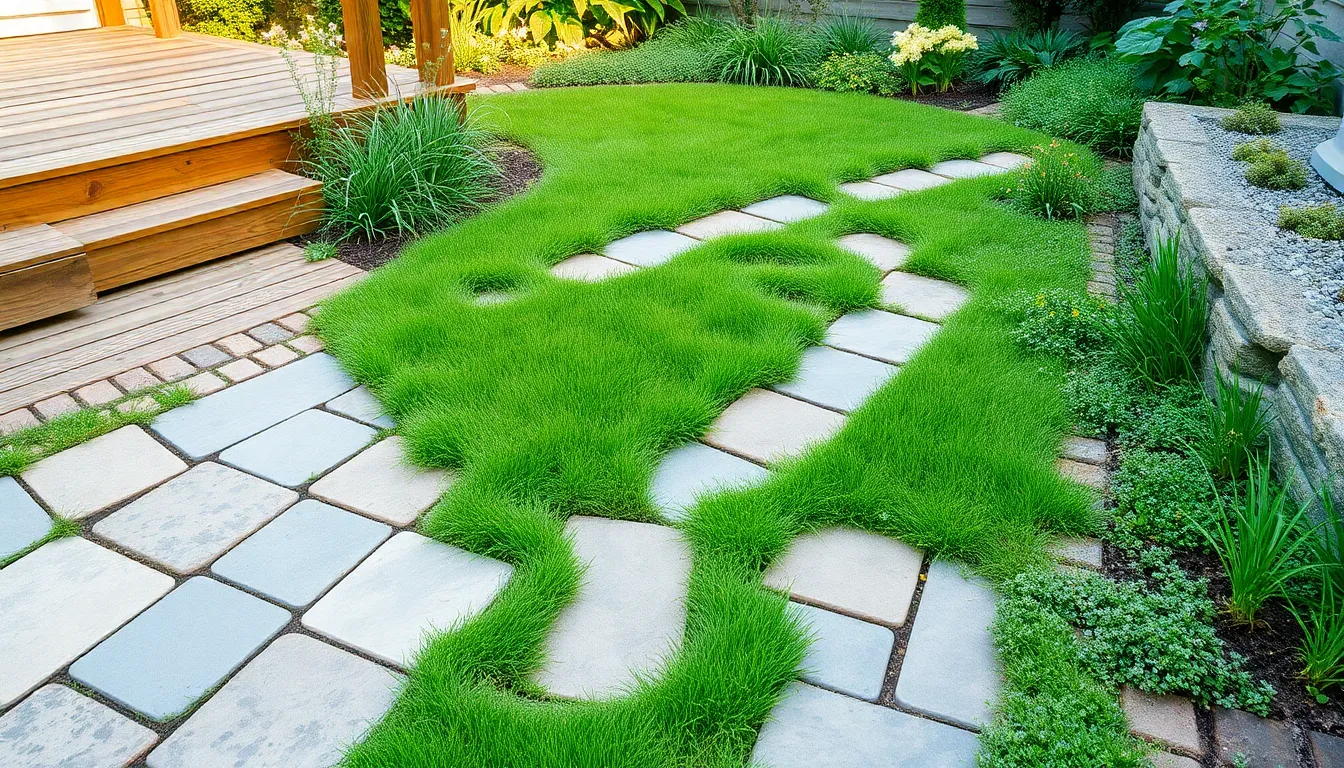
We can elevate our garden spaces by thoughtfully combining different flooring materials that complement each other while serving distinct functional purposes.
Blending Stone and Wood Elements
Flagstone paired with wooden decking creates natural transitions between formal and casual outdoor areas. We position flagstone sections near the house for durability and high-traffic use, then seamlessly connect to wooden deck areas for relaxation spaces. This combination offers both the organic appeal of natural stone and the warmth of wood elements.
Slate tiles integrated with composite wood provide modern sophistication while reducing maintenance demands. We use slate’s sleek surface for dining areas where spill resistance matters, then transition to composite decking for seating zones. The contrast between slate’s cool tones and wood’s organic textures adds visual depth to contemporary garden designs.
Natural stone pathways connecting wooden platforms establish flow throughout larger outdoor spaces. We create stone walkways that lead to elevated wooden deck sections, allowing each material to showcase its strengths. Stone handles ground-level traffic and weather exposure while wood provides comfortable elevated surfaces for furniture and activities.
Incorporating Plants Between Flooring Materials
Grass planted between stone pavers brings life to hardscaped areas while maintaining structure and function. We space pavers to accommodate grass growth, creating natural drainage channels that prevent water pooling. This living floor combination requires minimal maintenance once established and provides visual softness against hard stone surfaces.
Creeping thyme nestled between brick elements offers fragrant, low-maintenance ground cover that withstands foot traffic. We plant thyme varieties in gaps between brick pavers, creating aromatic pathways that release pleasant scents when stepped on. This approach adds color variation throughout growing seasons while requiring less water than traditional grass options.
Moss cultivation in stone joint spaces develops naturally in shaded garden areas with consistent moisture. We encourage moss growth between flagstone pieces by maintaining proper humidity levels and protecting from direct sunlight. Moss creates an aged, woodland aesthetic that complements rustic garden themes.
Design Tips for Seamless Transitions
Gradual level changes prevent abrupt shifts between different flooring materials and create natural flow patterns. We design gentle slopes or single-step transitions rather than dramatic height differences, ensuring safe navigation and visual continuity. Subtle elevation changes guide movement through garden spaces while accommodating drainage requirements.
Common color palettes unify diverse materials and maintain visual harmony throughout mixed-material installations. We select stones, woods, and accent plants that share complementary tones, preventing the combination from appearing disjointed. Neutral base colors with strategic accent hues create cohesive designs that feel intentional rather than random.
Proportional material distribution balances visual weight and prevents any single element from overwhelming the overall design. We allocate larger areas to primary materials while using secondary options as accents or transition zones. This approach ensures each material contributes meaningfully to the garden’s aesthetic without competing for attention.
Conclusion
Creating the perfect garden floor requires balancing aesthetics functionality and budget considerations. Whether we choose natural stone for timeless elegance wooden decking for warmth or innovative synthetic materials for low maintenance each option offers unique benefits for our outdoor spaces.
The key to success lies in understanding our exact needs and matching them with the right flooring solution. From traditional brick patterns to creative mixed-material combinations we have countless opportunities to design outdoor environments that reflect our personal style while addressing practical requirements.
By investing in quality garden flooring we’re not just improving our property’s appearance – we’re creating functional outdoor living spaces that enhance our daily lives and provide long-term value for our homes.
Frequently Asked Questions
What are the most popular garden flooring materials?
The most popular garden flooring materials include natural stone (flagstone, slate, limestone), wooden decking (natural wood and composite), gravel and pebbles, brick and pavers, concrete, and artificial grass. Each material offers different benefits in terms of aesthetics, durability, maintenance requirements, and cost, allowing homeowners to choose based on their specific needs and preferences.
How much does natural stone garden flooring cost?
Natural stone flooring costs vary significantly by type. Flagstone typically ranges from $15-25 per square foot installed, slate costs $10-20 per square foot, and limestone ranges from $12-22 per square foot. While the upfront investment is higher than other materials, natural stone offers excellent longevity and low maintenance needs, making it cost-effective long-term.
Which garden flooring requires the least maintenance?
Artificial grass and synthetic turf require the least maintenance, eliminating the need for watering, mowing, or fertilizing. Gravel and pebble flooring also offer low maintenance, requiring only occasional raking and weed removal. Composite decking is another low-maintenance option that doesn’t need regular staining or sealing like natural wood.
Can I install garden flooring myself?
Yes, many garden flooring options are DIY-friendly. Concrete pavers, gravel, and some composite decking systems can be installed by homeowners with proper preparation and tools. However, natural stone installation and complex patterns may require professional expertise to ensure proper drainage, level surfaces, and long-lasting results.
What’s the difference between natural wood and composite decking?
Natural wood decking offers authentic beauty and warmth but requires regular maintenance including staining, sealing, and weather protection treatments. Composite decking combines wood fibers with synthetic materials, providing durability and low maintenance while resisting rot, insects, and weather damage, though it typically costs more upfront.
How do I choose the right gravel size for my garden?
Gravel size selection depends on your intended use and aesthetic preferences. Smaller gravel (pea gravel) works well for pathways and high-traffic areas, while larger stones are better for decorative accents and foundational layers. Consider comfort underfoot, visual cohesion with your garden design, and drainage requirements when making your selection.
Are permeable pavers better than traditional ones?
Permeable pavers offer significant environmental benefits by allowing water to pass through, reducing runoff and improving soil health. They’re excellent for eco-friendly gardening and areas with drainage concerns. However, they may require more maintenance to prevent clogging and are typically more expensive than traditional solid pavers.
What are the benefits of mixing different flooring materials?
Mixed-material combinations create visual interest, define different garden zones, and allow for seamless transitions between spaces. For example, pairing flagstone with wooden decking creates natural flow, while incorporating plants between materials adds life and softens hard surfaces. This approach also allows you to optimize each area’s functionality.
Is rubber flooring suitable for outdoor gardens?
Yes, rubber flooring is excellent for outdoor use, especially in children’s play areas and high-traffic walkways. It provides superior shock absorption, slip resistance, and durability against weather extremes. Recycled tire rubber options are eco-friendly and require minimal maintenance while withstanding heavy foot traffic and harsh conditions.
How can I ensure proper drainage with my garden flooring?
Proper drainage starts with adequate base preparation, including grading for water flow away from structures. Permeable materials like gravel naturally promote drainage, while solid surfaces need proper slope installation. Consider drainage channels, permeable joints between pavers, or incorporating permeable materials in your design to prevent water accumulation.

